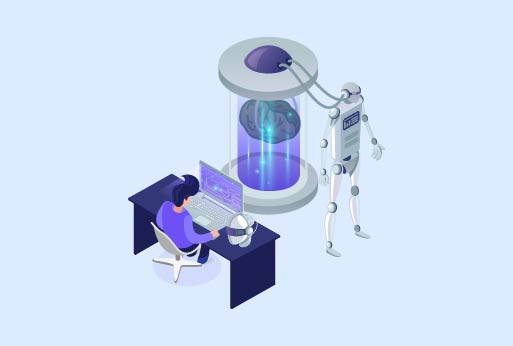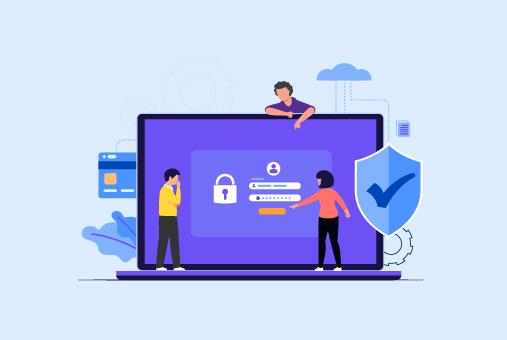
AI in Cybersecurity: The Double-Edged Sword of Advanced Defense and Sophisticated Attacks
Cybercrimes are increasing, so technology is getting advanced with it. Before, manual ways were used to prevent cyber threats. However, it’s the era of Artificial Intelligence, and it is creating a great impact on fighting against cyber vulnerabilities. Involvement of AI in cybersecurity works efficiently to detect cyber threats instantly. AI works like a strong tool here, which minimizes human tasks and makes things automated with AI. On the contrary, hackers are aware of the advancement in AI, so they are developing stronger tools and software that can enter the user’s systems more quickly, bypassing all the security protections.
Today, people are using AI to protect their systems from cyberthreats. Just like people are using it to secure their online data, it has also increased the risk that it will be used by the wrong people. In this blog, you will learn both aspects of AI in cybersecurity, the positive and negative ways, and also the protective measures if you get into any cyberthreat.
The Power of AI in Defense
Cyber attacks are tremendously increasing every day. There are more than thousands of cyber threats that are happening daily. AI has become a powerful tool in identifying cyber threats; these tools are created from smart algorithms that instantly identify threats on the network. In no time, an AI tool that is programmed well. Let you know the risk in your system. Artificial Intelligence in cybersecurity has made make work of cybersecurity engineers a bit efficient.
However, no matter how much AI in cybersecurity may advance, there are security methods like 2FA, Biometric verification, and other security options that can be used on applications you use. Moreover, there are authenticator apps that are used to generate codes that can be used in 2FA. AI can never replace these methods, which have been working efficiently on all applications successfully for a long time. Using AI is not recommended that you should stop using these methods to enhance your overall security on online platforms.
Intrusive Detection System IDE works smartly with the involvement of AI (AI checker), making the detection of threats more effective by learning from past attacks. AI in cybersecurity can detect phishing links. Determining the signs that the links attached in the email are malicious and can be a phishing attack. Since finding out whether the link is phishing or not, it can be difficult to detect.
The notable aspect of AI is that it detects the threat instantly without waiting for hours or days. This lets cybersecurity engineers take spontaneous action. This helps the company to work over the cyber attack quickly, so it won’t become a major threat for the employees, the clients, and the company itself.
What are the Risks that AI brings?
Artificial Intelligence in AI has a great impact; however, it brings a lot of potential risks with it. Some of the AI challenges are as follows:
Easy Hacking
Hackers can easily search for loopholes in your system, unlike before with using AI. They have created their software programs with AI models for hacking purposes. You can check for any open doors in the system where they can steal your data. For the prevention form hacking, use an iPhone VPN app for enhanced security.
Deepfake content
This AI risk is getting very common; it can be used positively, but hackers are using it to trick others. Cybercriminals pretend to be someone authentic from an organization by using the AI-generated voice of that person and misuse it by taking an amount from the CEO to a fake account. In such cases, tools like an AI Voice Detector (AI detector) can help identify synthetic voices and reduce the risk of falling victim to impersonation scams. Creating fake AI videos is commonly used for personal interests
AI Email Scams
It was easier before to detect the fake email scams promptly, because of having grammatical errors or odd wordings. However, now scammers use AI to generate these fake emails; they seem so professional that you start believing them. They may share links that may contain a virus; on clicking them, your system can get hacked, or a virus can be injected into it.
Bot Attacks
Integrating AI on botnets causes severe trouble to online users, as they are much faster and can spread malware to the site quickly. This way lot of websites and applications can be hacked, and data breaches are done on a large scale. One of the attacks is a DDoS attack in which a bot overloads a website with fake traffic, which slows down the website for other users.
Spreading False News
Companies or agencies use AI to spy on people under them. If it gets into the hands of the wrong people, they can misuse it by getting the personal details of people and blackmailing them for money. It is also used to create fake news on social media platforms to create irrelevant curiosity among people regarding someone, the government, or anything else.
What is the Future of AI in Cybersecurity?
The future of AI is great in the field of cybersecurity, helps in detecting all types of online threats in no time. Use of AI can detect the weak points beforehand, and cybersecurity experts can then take the right actions against the threats. AI structures will face new challenges, and at the same time, as improved encryption is important, it should be balanced in opposition to the risk of more state-of-the-art Al-pushed hacks.
Professionals need to continuously update their technology over time, and also make their employees and others familiar with the AI technology so it can be used effectively. It does not mean that all the previous knowledge goes in vain, but the involvement of Artificial Intelligence with that knowledge can help work smartly and quickly.
Conclusion
Although AI in cybersecurity is a blessing, the detection of cyberthreats has become easier and faster; checking for the threats manually is time-consuming and has a chance to human error. But as it has a lot of advantages, AI has several risks as well. If criminals get into this, then your data isn’t safe; they can send you fake emails generated with AI, or create fake videos or audios to trick others. Companies should get familiar with AI in cybersecurity so in no time any threat can be tackled with intelligence.




